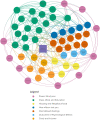What is missing from how we measure and understand the experience of poverty and deprivation in population health analyses?
- PMID: 37862435
- PMCID: PMC10710332
- DOI: 10.1093/eurpub/ckad174
What is missing from how we measure and understand the experience of poverty and deprivation in population health analyses?
Abstract
Background: Explaining why some populations are healthier than others is a core task of epidemiology. Socioeconomic position (SEP), encompassing a broad range of exposures relating to economic circumstances, social class and deprivation, is an important explanation, but lacks a comprehensive framework for understanding the range of relevant exposures it encompasses.
Methods: We reviewed existing literature on experiential accounts of poverty through database searching and the identification of relevant material by experts. We mapped relevant concepts into a complex systems diagram. We developed this diagram through a process of consultation with academic experts and experts with direct experience of poverty. Finally, we categorized concepts on the basis of whether they have previously been measured, their importance to the causal flow of the diagram, and their importance to those consulted, creating a list of priorities for future measurement.
Results: There are a great many aspects of SEP which are not frequently measured or used in epidemiological research and, for some of these, work is needed to better conceptualize and develop measures. Potentially important missing aspects include stigma, social class processes, access to education, sense of lost potential, neighbourhoods, fairness and justice, emotional labour, masking poverty, being (in)visible, costs, and experiences of power.
Conclusions: Analyses seeking to understand the extent to which SEP exposures explain differences in the health of populations are likely to benefit from a comprehensive understanding of the range and inter-relationships between different aspects of SEP. More research to better conceptualize and measure these aspects is now needed.
© The Author(s) 2023. Published by Oxford University Press on behalf of the European Public Health Association.
Figures
Similar articles
-
Social Susceptibility to Multiple Air Pollutants in Cardiovascular Disease.Res Rep Health Eff Inst. 2021 Jul;2021(206):1-71. Res Rep Health Eff Inst. 2021. PMID: 36004603 Free PMC article.
-
Effects of short-term exposure to air pollution on hospital admissions of young children for acute lower respiratory infections in Ho Chi Minh City, Vietnam.Res Rep Health Eff Inst. 2012 Jun;(169):5-72; discussion 73-83. Res Rep Health Eff Inst. 2012. PMID: 22849236
-
The future of Cochrane Neonatal.Early Hum Dev. 2020 Nov;150:105191. doi: 10.1016/j.earlhumdev.2020.105191. Epub 2020 Sep 12. Early Hum Dev. 2020. PMID: 33036834
-
The Minderoo-Monaco Commission on Plastics and Human Health.Ann Glob Health. 2023 Mar 21;89(1):23. doi: 10.5334/aogh.4056. eCollection 2023. Ann Glob Health. 2023. PMID: 36969097 Free PMC article. Review.
-
Living on the margin: a salutogenic model for socio-economic differentials in health.Public Health. 1995 Jul;109(4):235-43. doi: 10.1016/s0033-3506(95)80200-2. Public Health. 1995. PMID: 7667487 Review.
Cited by
-
Does household income predict health and educational outcomes in childhood better than neighbourhood deprivation?J Public Health (Oxf). 2025 Feb 28;47(1):62-73. doi: 10.1093/pubmed/fdae283. J Public Health (Oxf). 2025. PMID: 39657973 Free PMC article.
References
-
- Phelan JC, Link BG, Tehranifar P.. Social conditions as fundamental causes of health inequalities: theory, evidence, and policy implications. J Health Soc Behav 2010;51(Suppl):S28–40. - PubMed
-
- Friel S, Townsend B, Fisher M, et al.Power and the people’s health. Soc Sci Med 2021;282:114173. - PubMed
-
- Galobardes B, Lynch J, Smith GD.. Measuring socioeconomic position in health research. Br Med Bull 2007;81-82:21–37. - PubMed



